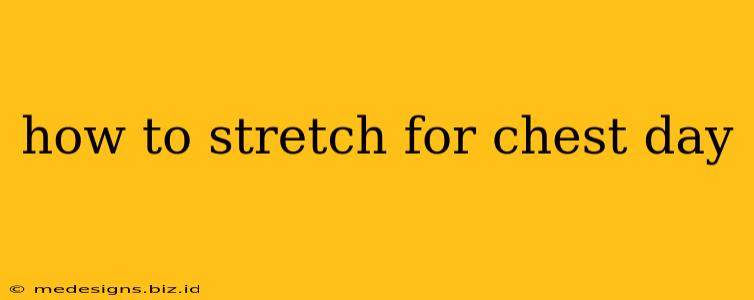Chest day can leave your pecs feeling tight and achy. Proper stretching before and after your workout is crucial for maximizing your gains, preventing injuries, and improving your overall flexibility. This guide will walk you through effective stretches to incorporate into your chest day routine.
Why Stretching Before and After Chest Day is Important
Before diving into the stretches, let's understand why stretching is so vital for chest day:
- Improved Range of Motion: Stretching increases your range of motion, allowing you to lift heavier and perform exercises with better form. This leads to greater muscle activation and overall strength gains.
- Injury Prevention: Tight chest muscles can increase your risk of injuries like strains and tears. Stretching helps to loosen up the muscles, making them more resilient.
- Increased Blood Flow: Stretching improves blood flow to your chest muscles, delivering essential nutrients and oxygen that aid in muscle recovery and growth.
- Reduced Muscle Soreness: Post-workout stretching can significantly reduce muscle soreness and stiffness, making your next workout more comfortable.
- Enhanced Flexibility: Consistent stretching improves your overall flexibility, contributing to better posture and overall physical well-being.
Best Stretches for Before Your Chest Workout (Dynamic Stretching)
Dynamic stretches involve movement and are ideal for warming up your muscles before a workout. They increase blood flow and prepare your muscles for the exertion ahead.
- Arm Circles: Perform both forward and backward arm circles. Start with small circles and gradually increase the size. Do 10-15 repetitions in each direction.
- Chest Stretches with Resistance Band: Hold a resistance band with both hands, slightly wider than shoulder-width apart. Step forward with one foot and gently pull the band apart, feeling a stretch across your chest. Hold for a few seconds and repeat on both sides. Aim for 10-12 repetitions per side.
- Cross-Body Arm Stretch: Extend one arm across your body and gently pull it towards your chest with your opposite hand. Hold for 15-20 seconds and repeat on the other side. This targets the pectoral muscles effectively.
- Dynamic Push-Ups: Perform a few slow, controlled push-ups, focusing on the stretch at the bottom of the movement. Don’t go all the way down to the floor if it causes discomfort.
Best Stretches for After Your Chest Workout (Static Stretching)
Static stretches involve holding a position for a period, allowing your muscles to lengthen and relax. These are perfect for post-workout recovery.
- Doorway Pec Stretch: Stand in a doorway with your forearms resting on the door frame, elbows at shoulder height. Lean forward until you feel a stretch in your chest. Hold for 30 seconds.
- Towel Chest Stretch: Hold a towel behind your back with both hands. Gently pull the towel outwards, feeling a stretch across your chest. Hold for 30 seconds.
- Lying Chest Stretch: Lie on your back with your arms extended to the sides. Gently pull one arm across your body towards the floor, using your other hand to assist. Hold for 30 seconds and repeat on the other side.
- Floor Pec Stretch: Lie face down with your arms extended to the sides. Push off the floor with one arm, feeling a stretch across your chest. Hold for 30 seconds and repeat on the other side.
Important Considerations for Chest Stretching:
- Listen to Your Body: Don’t force any stretch that causes sharp pain. A gentle, comfortable stretch is key.
- Consistency is Key: Regular stretching is more effective than occasional stretching. Aim to incorporate these stretches into your routine consistently.
- Proper Form: Focus on maintaining proper form throughout each stretch to maximize effectiveness and prevent injuries.
- Breathing: Remember to breathe deeply and evenly during each stretch. Exhaling can help deepen the stretch.
By incorporating these stretches into your chest day routine, you can significantly improve your workout performance, prevent injuries, and enhance your overall fitness. Remember to prioritize proper form and listen to your body's signals for optimal results.
